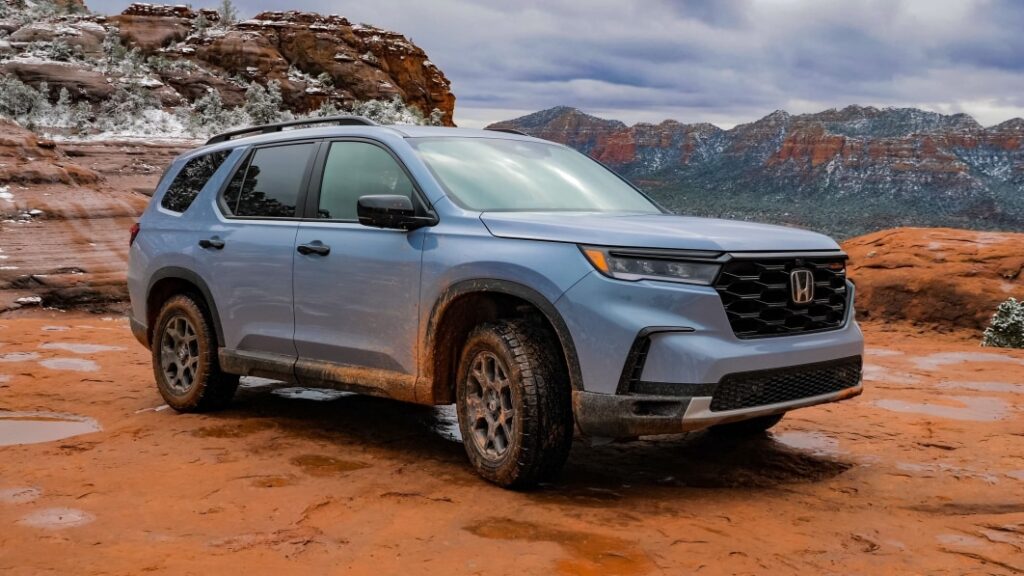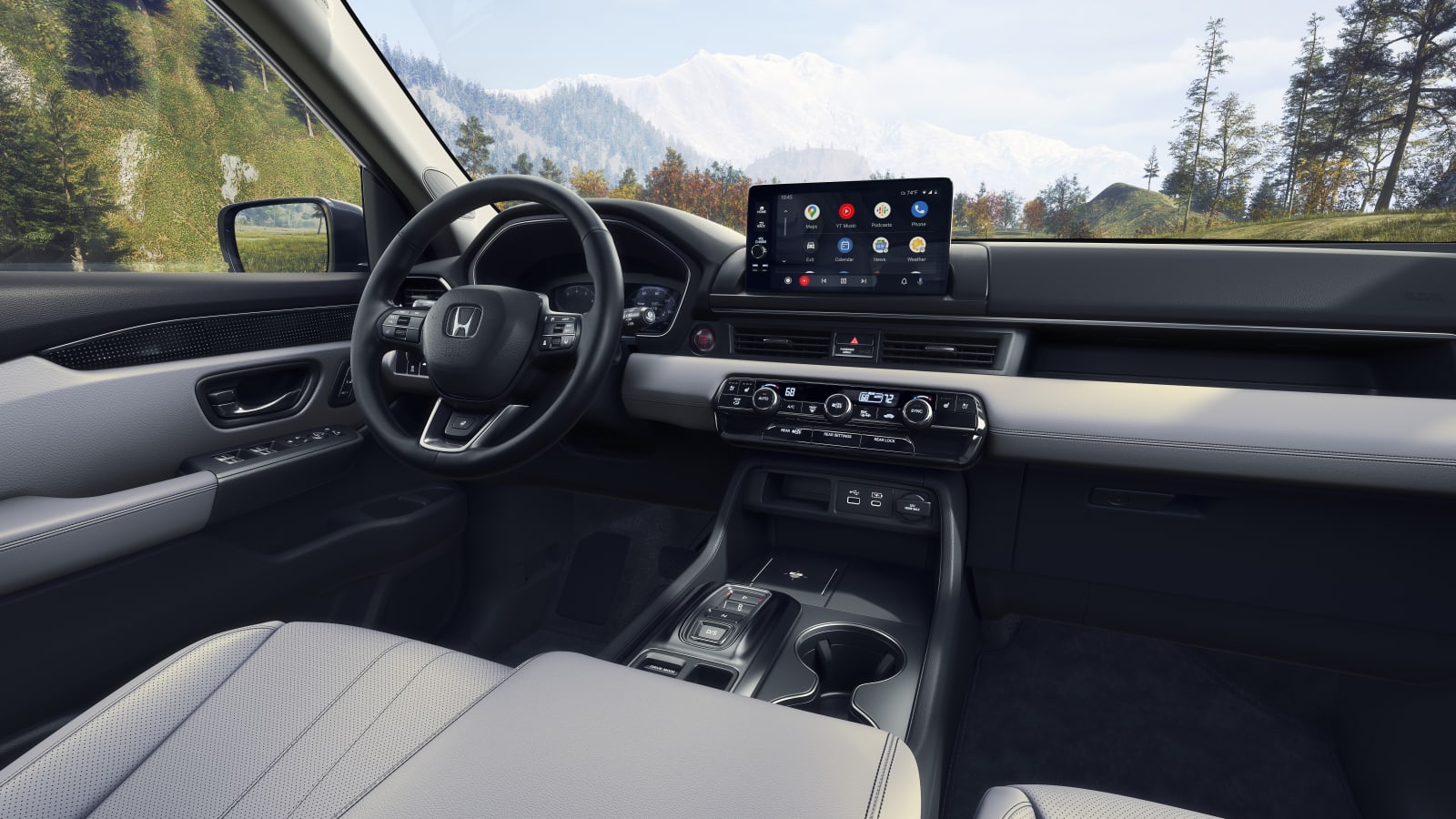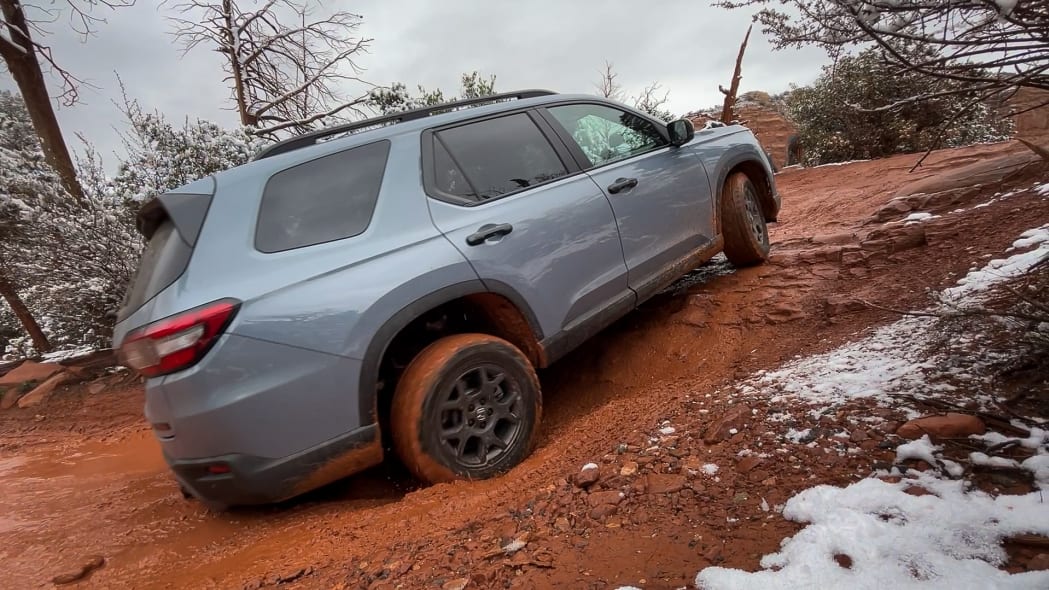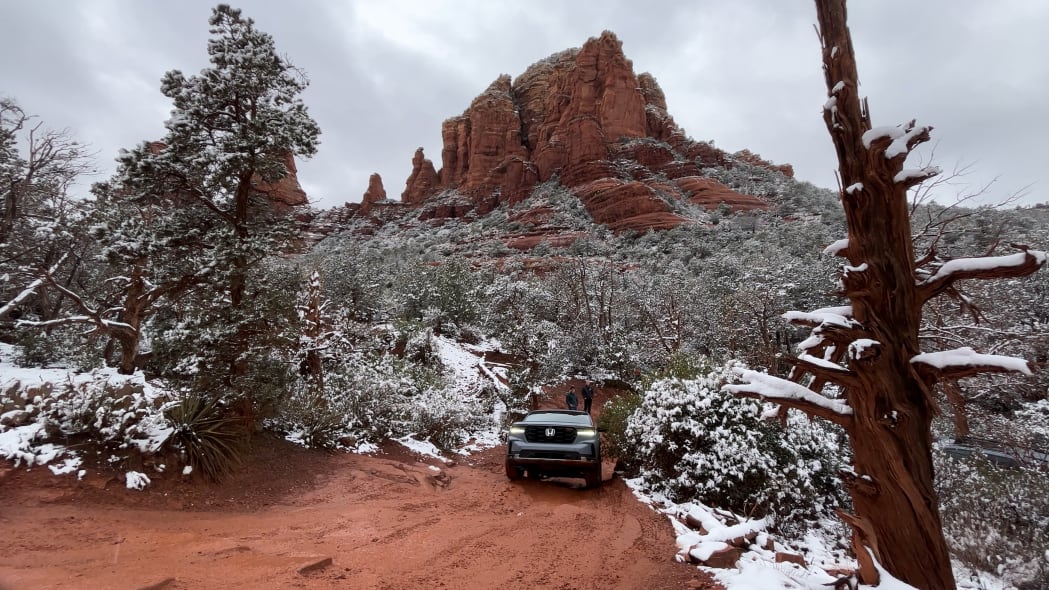2023 Honda Pilot First Drive | Broad strokes and broader shoulders

SEDONA, Ariz. — Honda’s fourth-generation Pilot is here in all of its squared-off, butched-up glory. Packing an updated powertrain with new drive modes and an upgraded TrailSport model for the outdoorsy types, the overhauled three-row wades into a segment where every new entry seems to push the boundaries of jack-of-all-trades utility and light-duty adventuring.
For a more comprehensive overview of the new features in the 2023 Honda Pilot, check out our First Look from November.
Honda picked Sedona because it was one of many places across the country where its engineers spent time testing the capabilities of its new TrailSport models, Pilot included. Home turf, if you will. What the company didn’t count on was a freak January snowstorm that paralyzed the small town’s main arteries for several hours on the morning of our test drive. Neither the Elite nor the TrailSport models Honda brought along for evaluation were equipped with snow tires, so we were cautioned about following distances and slick hills before being released into the snow-covered desert.
We started our drive in a TrailSport. The unique conditions provided an opportunity to test one of the fourth-gen Pilot’s new additions: selectable drive modes. Sure enough, “Snow” is one of them, and paired with the Continental all-terrains, it handled the slop with aplomb. A full-ABS braking test found reasonable grip from the knobby A/Ts even on icy hills, giving us confidence that we’d be able to get by on some of the area’s steeper inclines.
A set of knobby tires might prompt concerns among those of you who know Honda’s history of delivering models that suffer a bit more than average from wind and road noise intrusion, but the Contis were admirably quiet even on rough desert asphalt. After trading in the TrailSport for an Elite, we actually found the latter’s all-seasons to be a bit more talkative on messy pavement, but the weather conditions and rather generous application of what appeared to be cinder treatment on the roads made for a challenging testing environment.
Both models are powered by the Pilot’s new standard 3.5-liter V6. Yes, that may sound like a carryover, but is in fact a new, DOHC design. Power was bumped ever so slightly to 285 horsepower and 262 pound-feet (up from 280 hp and 262 lb-ft) and the 10-speed automatic (with paddle shifters!) returns. Standard on the TrailSport and Elite, and optional on the other trims, is the second-generation of Honda’s i-VTM4 torque-vectoring all-wheel-drive system. It features a stronger rear diff that can handle 40% more torque while responding 30% quicker. As much as 70% of the engine’s power can be sent to the rear axle, with 100% of that transferred to one wheel.
Sedona sits more than 4,000 feet above sea level. Those altitudes are borderline hostile to naturally aspirated engines, to the tune of a roughly 40-horsepower deficit. That made Honda’s choice of testing venues a bold one. A turbocharged unit would lose a lot less of its wind out here, but the V6 held its own despite the Pilot’s heft. The standard 2WD model checks in at a reasonable 4,030 pounds. The AWD models we sampled are a good bit heavier — 4,685 for the TrailSport and 4,660 for the loaded-up Elite. Heavy though these figures may sound, they’re in line with the Highlander Platinum (4,453 pounds) and Pathfinder Rock Creek (4,605 pounds). And for context, all of them weigh less than even a two-row Jeep Grand Cherokee Overland (4,721 pounds).
Speaking of the competition, Honda is looking to one-up the Nissan’s sliding second-row and handy removable console. The Pilot can now be optioned with a removable center seat in the second row, allowing you to convert your 8-passenger model to 7-passenger duty with far better access to the third row. Even better, the seat can be stowed in the under-floor cargo area behind the third row in case you need to bring it with you (or have cause to remove it in the middle of an outing). It weighs about 45 pounds and it’s a bit unwieldy, but it comes out in seconds and removal requires no tools. Honda supplies a sturdy tie-down strap to secure it in the rear cubby while you drive. Unfortunately, this knocks it out of contention as a TrailSport option, as the full-sized spare intrudes too far into the rear cargo area.

That’s not the only interior upgrade. Honda chucked the Pilot’s old cabin out the window entirely in favor of a new, much sleeker and more upscale look. Honda says the Pilot’s front seats were redesigned for better support and reduced fatigue. The updates appear to have paid dividends, as we had zero complaints about their shape or adjustability. Materials, fit and finish all show improvements over the previous generation. There’s no under-console storage, but there is ample space inside along with room for doodads in the recessed portion of the dash.
Whether you opt for the standard 7-inch infotainment system or the 9-inch upgrade, the physical-button-to-touchscreen-control ratio is favorable. USB-A and USB-C plugs are available on the center console for smartphones, as is a standard 12-volt DC outlet. USB-A charging is also standard in the second row; third-row ports become standard at EX-L and above. A wireless charger sits below them (on models so equipped) for easy access.
The Bose system on the Elite is the first branded audio offered in Pilot’s history; our testing environment wasn’t the best for audio evaluation; that’ll have to wait for a future road test. Wired Android Auto and Apple CarPlay are standard (wireless is standard on EX-L or better). We were able to pair and use Android Auto with virtually zero effort. Honda’s new infotainment isn’t perfect, but it’s certainly much better than what we were used to seeing from them just a couple of model years ago.
That said, the 10.2-inch digital cluster exclusive to the Elite is cool to look at, but doesn’t bring much functionality to the table. We also have to dock Honda a few points for sticking to those corny digital temperature readouts on the HVAC controls. That’s not the brand of nostalgia we’re itching for. And the single 3.0-amp USB-C port up front is a good start, but we’d like to see more of those in the rear cabin area.
With Pilot, Honda is entering the second phase of its TrailSport rollout. While the 2022 Pilot and Passport TrailSport conveyed the general direction Honda intends for the sub-brand, the 2023 Pilot is the first ground-up execution of the concept, building on the slight suspension lift and wheel/tire package that was offered for 2022. For 2023, that lift grows to an inch, for a respectable but not 4×4-rivaling 8.3 total inches of ground clearance. You also get steel skid plates for the oil pan, transmission and gas tank; a full-size spare tire; smaller stabilizer bars for improved off-road articulation and a trim-exclusive “Trail” mode for Honda’s new drive mode system.
Our time in Sedona reinforced our experiences with the prototype TrailSport we briefly sampled last year. No longer a sleepy woo-woo backwater, the little Arizona town is now chock-full of premium crossovers and SUVs. As we quickly learned, however, their ubiquity ends where the pavement does.
Honda led us up Broken Arrow Trail (rated “Moderate”) in a small convoy, taking time to explain each of the obstacles we’d encounter but offering very little in the way of concrete guidance apart from “follow the leader” or “watch out for this one sharp rock.” Lacking the beefy truck underpinnings of a true full-size SUV, you’d expect the Pilot to be a complete fish out of water in these slick, snow-dusted surroundings, but instead it felt right at home. The “Trail” mode steering calibration is pretty much perfect, and the wheel communicates traction loss admirably for a heavily digitized setup.
Competent though it may be, the Pilot is large, and size is the enemy of agility, especially when you’re talking about a unibody, FWD-based crossover like this one. We found ourselves leaning heavily on its “TrailWatch” camera setup in tighter spots. It pairs an overhead fisheye view with a nose camera that reveals obstacles directly in front of the car. The cameras come on automatically when you put the car in “Trail” mode and remain on up to 15 mph; you can also toggle them on or off in the infotainment system.
Honda’s torque-vectoring all-wheel-drive system can put up to 75% of available torque through any one given wheel in “Trail” mode, with the other 25% kept in reserve in case a second wheel gets grip. That came in handy on slick rock climbs, but (and this also goes for the Pilot’s hill descent control feature) you can’t beat locking differentials and a low-range gearbox — two things absent here — for low-speed crawling.


When we arrived at Chicken Point, we found ourselves surrounded by wine-drunk vacationers who told us they’d paid $180 a head to ride up the same trail in an open-top Jeep (in 30-degree Fahrenheit weather, mind you). At those rates, we left $900 on the table. Taking in that view surrounded only by experienced tour drivers and a small handful of do-it-yourselfers in 4Runners, Land Cruisers and Jeeps certainly drove home the point that even “soft-roaders” are far more capable that we give them credit for.
At $37,295 to start, the Pilot slots in almost perfectly with the Nissan Pathfinder and the standard Toyota Highlander. But that’s a decent-sized bump for the LX model, which was on hiatus for 2022. MSRP for that back in 2021 was just $33,370 with destination; just keep in mind, that spec wasn’t subject to the inflation-related price hikes we saw industry-wide in 2022.
Comparing like-for-like, the Sport model’s price increased by $1,070, which isn’t too painful considering the robustness of its upgrades. The EX-L starts at $43,295, Touring at $47,795 and Elite at $53,375.
And then there’s TrailSport. It’s the sharpest looking and arguably the best to drive, both on-road and off, but it slots in just below the top-trim Elite at a healthy $49,695. Even this new-and-improved version is not a game-changer, nor was it meant to be. It’s merely an assurance from Honda that the Pilot’s ruggedized looks aren’t merely for show. It’s no substitute for a proper 4×4, but we’d bet dollars to donuts that most owners would run out of courage long before the TrailSport runs out of capability.
And that’s pretty much the point of the 2023 Pilot. It’s still comfortable, roomy and versatile, but now it offers a little something extra for those who have the gumption to venture off the beaten path from time to time. Its lowlights are few. In addition to the tech shortcomings we already touched on above, we’re left a bit cold by the Pilot’s one-size-fits-all powertrain. To be fair, it’s not that unusual for the class, and none of Honda’s competitors is setting the world on fire either, but some additional hybrid and turbocharged options would certainly shake things up a bit.
Related video:




